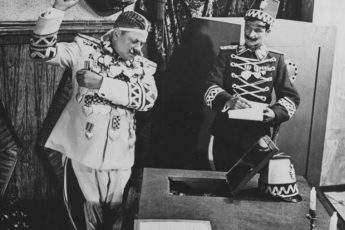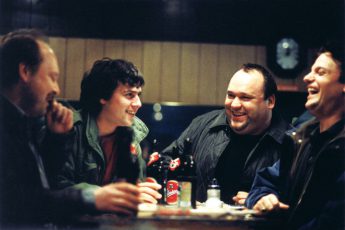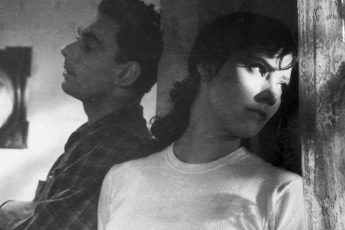Your Head in Your Hands
Boris Yukhananov’s video-novel The Mad Prince (Sumashedshiy Prints, 1986-)
Vol. 109 (November 2020) by Gordei Petrik
Boris Yukhananov has described his The Mad Prince, a cycle of films shot by the director in the late 1980s with the only known VHS camera in Moscow and Leningrad, as a “video-novel for a thousand cassettes”. Five films have been edited out of the material, with each of them lasting about an hour (16 were originally planned and it is possible that new chapters will be released in the future).
A significant part of the first chapter “The Mansion” takes place in an apartment during a performance of Theater Theater — the first independent theater group in the USSR which was headed by Yukhananov himself. In the first minutes of the film, Anzhey Zakharishchev von Braush, the frontman of the band Obermaneken, draws the opening credits on the front shield of a car. Artists Timur Novikov, Oleg Kotelnikov and Gustav Guryanov perform an improvised performance entitled “The first uprising of the intelligentsia”. The spectators wander from room to room. Actress Ada Bulgakova reads a play by Tennessee Williams, and then pure hysteria is unleashed.
Such scenes — in which the documentation of a theatrical improvisation enters into a symbiosis with a documentation of life — make up the whole of The Mad Prince. Neither fiction films nor documentaries and consistently non-linear, the films making up this project only have a shadow of a plot (all of the films could be characterized as “post-docs”, a term coined by film critic Zara Abdullaeva 20 years after Yukhananov’s video project).
Or let’s take the second chapter “Playing XO”. Actor Nikita Mikhailovsky reads a heart-felt improvised monologue about the hardships of an underground artist in Russia. His friend Marat Gelfand soon emigrates to the United States and spends his last day in Moscow with the prostitutes of the Metropol Hotel. The camera turns to the TV screen: they are showing a movie about Stalin, a propaganda program about Zionism, and Buñuel’s and Dalí’s An Andalusian Dog, which Yukhananov embedded into the film and which seems almost rational against the backdrop of his own visions. The heroes, led by disguised Necrorealist Evgeny Yufit, carry out group suicide in the back room, and at the very end Gelfand tells the story of the repressions against his family members who do not want to keep remembering the Stalinist camps they were in.
In terms of mentioning Stalin and the Gulag, as well as the frequency of using the word “Sovdepia” in relation to screen time, The Mad Prince does not lag behind the revisionist spirit of the times of Perestroika. In the third chapter “Esther”, the topic of mass deportations comes up, and we see the totality of the tragedy through the prism of family drama.
Video, according to Yukhananov, is non-discrete. Unlike cinema, it proceeds on a time continuum, not being individuated in terms of scenes or frames. The video camera highlights vitality, which is so difficult to capture using studio equipment — how the heroes rage and grimace, how they read Anna Akhmatova’s poems and watch Fassbinder’s films, how they kiss, how they dance in the rain, how, leaning out of the windows, old men shout at them, and how passers-by ask them how the camera works, where it is from («Private? Wow!»). It’s multidisciplinary art. The process of creating a video and discussing its mechanisms plays a central role in The Mad Prince, as does the recording of performances or documentary filming. There is a reason why the first manifesto of Yukhananov’s video theory was called “You have your head in your hands”. Several times during filming, Yukhananov gives tasks to his actors — naturally, in front of the audience, creating one single body with his video camera.
The Mad Prince is also the portrait of a generation which was simultaneously shaped by homegrown dissidents and modern Western cultures, by esoteric ancient texts, classified aspects of Soviet history, and new technical possibilities. In “Esther”, the Old Testament text and Falco’s super-popular song “Jeanny” become equal leitmotifs. And the fourth chapter “Fassbinder” is devoted to defining the image of the German director: naked actors of the Theater Theater collective organize punk-performances based on Fassbinder’s late films and share stories about their imaginary meetings with Fassbinder.
The crucial innovation of Yukhananov in The Mad Prince is fatal editing. It is a revolutionary method of editing, when new material displaces already recorded material on the tape. In “Fassbinder”, the voice of underground film theoretician Evgeny Chorba, who lectures on the life of Fassbinder, interrupts von Brausch’s singing of “The Night Porter”, Obermaneken’s tribute to Liliana Cavani’s legendary film Il portiere di notte. And in the shocking fifth chapter “The Japanese”, a late Soviet program about young art, in which Yukhananov arranges a live-performance in the TV studio, the director intersperses the program with frames of an actual autopsy. At the same time, Evgeny Chorba lectures about The Mad Prince.
In the films of The Mad Prince, fiction cannot be separated from truth. Acting cannot be separated from living, poetic texts cannot be separated from speaking, and speculating on feelings cannot be separated from feeling these feelings. All these films end with some kind of meaningless farce, with empty small-talk or a stupid joke, as if breaking off in mid-sentence, leaving the viewer feeling that they could have went on. And in fact they do — in the head of the spectator.




Leave a Comment